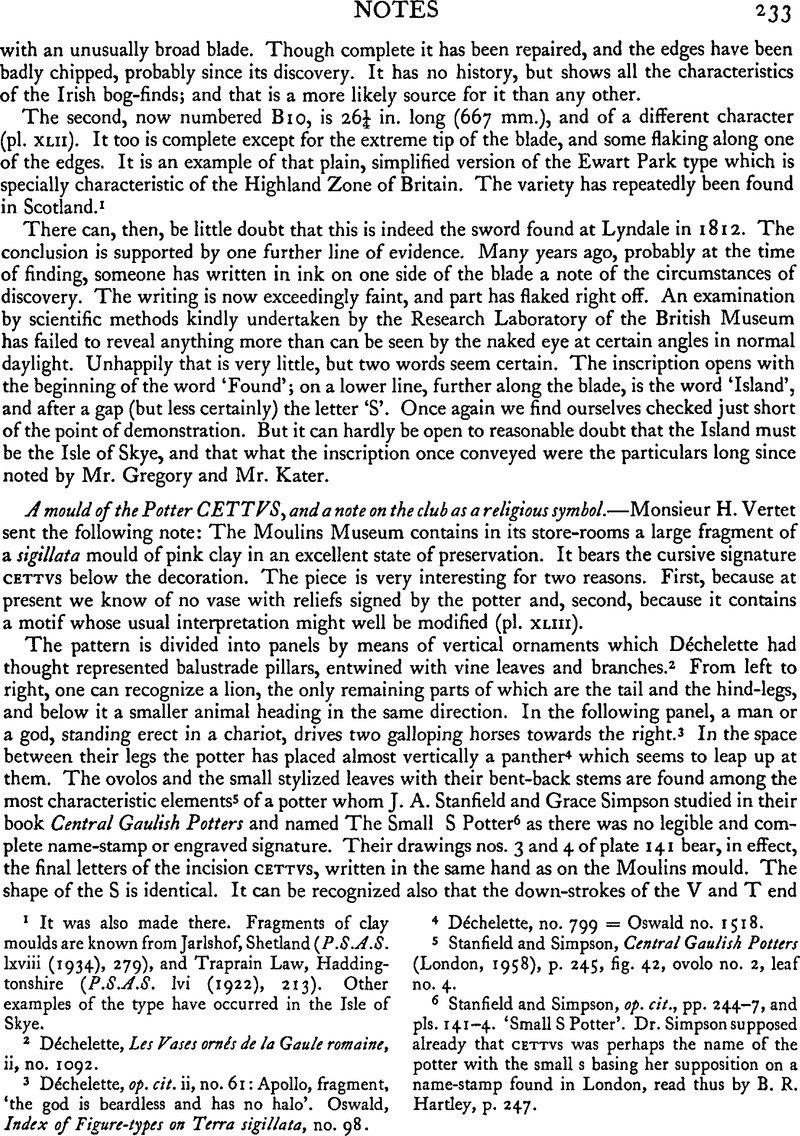No CrossRef data available.
Article contents
A mould of the Potter CETTVS, and a note on the club as a religious symbol
Published online by Cambridge University Press: 29 November 2011
Abstract

- Type
- Notes
- Information
- Copyright
- Copyright © The Society of Antiquaries of London 1961
References
page 233 note 2 Déchelette, Les Vases ornés de la Gaule romaine, ii, no. 1092.
page 233 note 3 Déchelette, op. cit. ii, no. 61: Apollo, fragment, ‘the god is beardless and has no halo’. Oswald, Index of Figure-types on Terra sigillata, no. 98.
page 233 note 4 Déchelette, no. 799 = Oswald no. 1518.
page 233 note 5 Stanfield, and Simpson, , Central Gaulish Potters London, 1958), p. 245Google Scholar, fig. 42, ovolo no. 2, leaf no. 4.
page 233 note 6 Stanfield and Simpson, op. cit., pp. 244–7, and pls. 141–4. ‘Small S Potter’. Dr. Simpson supposed romaine, already that cettvs was perhaps the name of the potter with the small s basing her supposition on a name-stamp found in London, read thus by B. R. Hartley, p. 247.
page 234 note 1 They are found on the fragments nos. 5, 7, 12), 15, 17, (20), 29, 30, 31, 42, (48), 51, 53, 54, 55), 56, 64.
page 234 note 2 Catalogue du Musie départemental de Moulins, 85, no. 533(b) bis, large mould fragment signed cettvs, from Lezoux, Tudot collection; Déchelette, op. cit. 162; C.I.L. xiii, 10011, 55.
page 234 note 3 Terrisse, , ‘Eine Sigillata-Töpferei in Martres de Veyre’, Germania, xxxii, 1954, 172Google Scholar, no. 25; Terrisse, ‘L'Officine des Martres-de-Veyre’, Ogam, no. 58–59, ×, 4–5, pl. li.
page 234 note 4 Déchelette gives this motif with a small base. It is also found thus in the work of docilis: cf. Stanfield and Simpson, op. cit., pl. 91, no. 1, and in the work of the potter with the large S, pl. 76, no. 33. Oswald did not include this small motif in his Index. He noted it, however, in the work of doccalvs in a marginal note written in his personal copy of Vases ornés de la Gaule romaine.
page 234 note 5 Alföldi, A., ‘The Bronze Mace from Willing-ham Fen, Cambridgeshire’, J.R.S., 1949, 19–22, pls. i–ivGoogle Scholar.
page 234 note 6 In Livia's house the club is placed on a stone base in the centre of the bosquet d'Artémis … ‘beneath the branches of a huge pine, whose foliage covers the background of the picture with a trellis-work of shadow and mystery … a strange object adorned with a hunting trophy’. Charbonneaux, J., L'Art au siécle d'Auguste, 1948, p. 47Google Scholar.
page 235 note 1 On Gallo-Roman pottery the circus charioteer is found: Déchelette, 646–7 = Oswald 1159–72, but designs made up entirely from the theme of hunting-horses do not seem to have been numerous. Three themes above all are known: hunting scenes (in the open country or in the circus), patterns of Bacchanalian inspiration, and vases with marine subjects; (Libertus, Carantinus …).
page 235 note 2 The Small S Potter has been dated from the period A.D. 160–195: Stanfieldand Simpson, op.cit., p. 247. During this period hunting and animal scenes are extremely frequent and constitute even a general characteristic of that style: Déchelette, op. cit. i, 187.
page 235 note 3 Cf., for example, Balil, A., ‘Fragmento de T. S. Aretina de Ampurias (Gerona)’, Arqueologia e historia, viii, 1958, 95–99Google Scholar; Arturo Stenico, ‘Ceramica aretina a relievo della coll. Pisani-Dossi del Museo di Milano’, Studi in onore di Aristide Calderini e Roberto Pariberi, iii, 1956, pl. viii, no. 189.
page 235 note 4 S. Reinach, Répertoire des peintures grecques et romaines, 1922, pp. 80–81. Eros riding or driving animals, p. 83, Eros hunting: the wild beasts are minute, cf. no. 5.
page 235 note 5 For example with Bargathes and Rasinius. Dragendorff-Watzinger, Arretinische Reliefkeramik, driving a chariot: no. 242 sqq., driving Pegasus: pl. xvi, no. 244, and p. 195; Arturo Stenico, La ceramica arretina, 1960, pl. 26, nos. 125–6, Rasinius.
page 235 note 6 On Gallo-Roman sigillata a large number of stamp-moulds representing cupids are found. Oswald gives 140 examples (nos. 376–516, pls. xx to xxv). At La Graufesenque, Lezoux, and La Madeleine, the theme of Cupid riding a dolphin appears, the same as that at Arrezo and in the Baths of Ostia for example (cf. S. Reinach, op. cit., p. 79, no. 6, thermes d'Ostie; Dragendorff-Watzinger, op. cit., suppl. 9, no. 77, vase de c. tellivs (concerning this theme refer to the same page note 2), Arrezo; Oswald, no. 17, pl. ii; Hermet, Li Graufesenque, no. 199, pl. 22; Oswald, op. cit., no. 44A, Lezoux, no. 44. La Madeleine).
page 235 note 7 Professor Alföldi, op. cit., points out the design of Diana's pillar on the lid of an early silver box, bought from an antique dealer in Berlin; this motif had therefore been used on metal vases, but we have no information concerning the date of the object.
page 235 note 8 I wish to thank Lloyd Upton and Grace Simpson for their kind help with the translation of this article.




